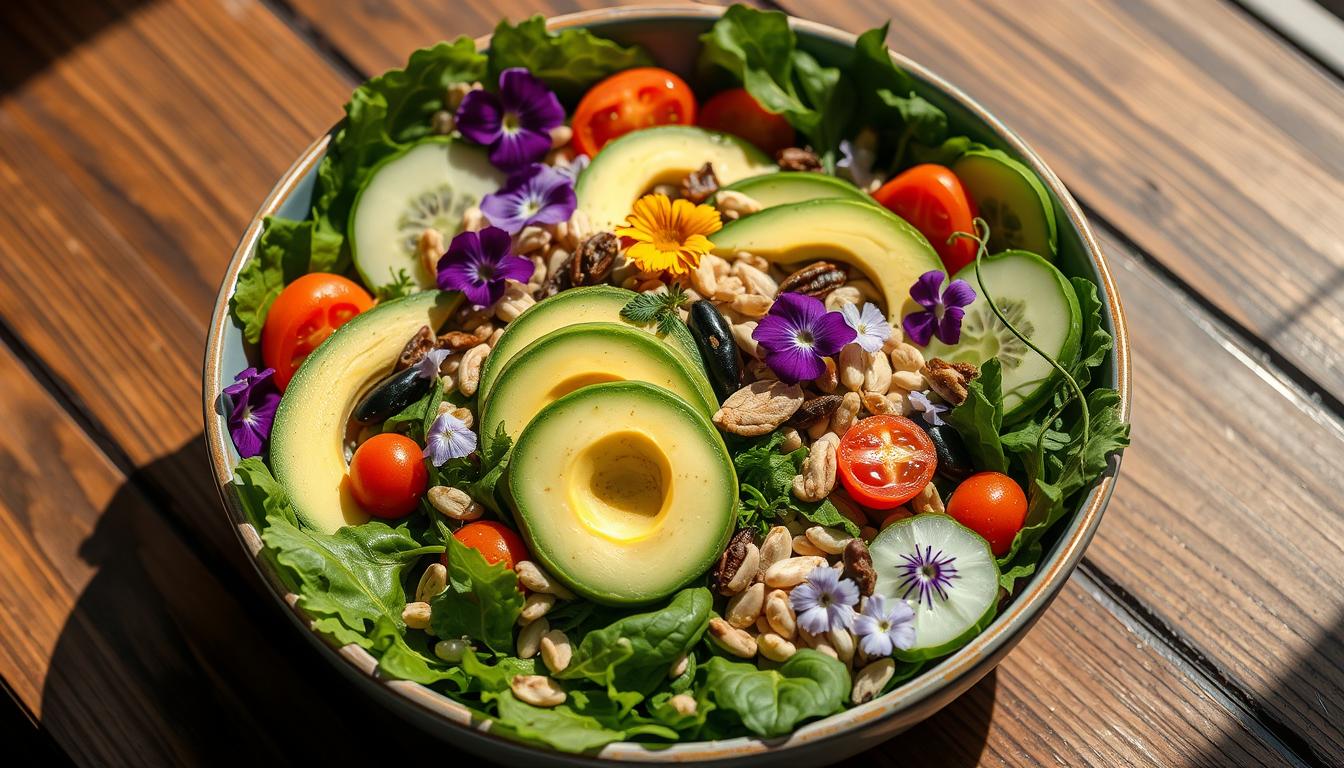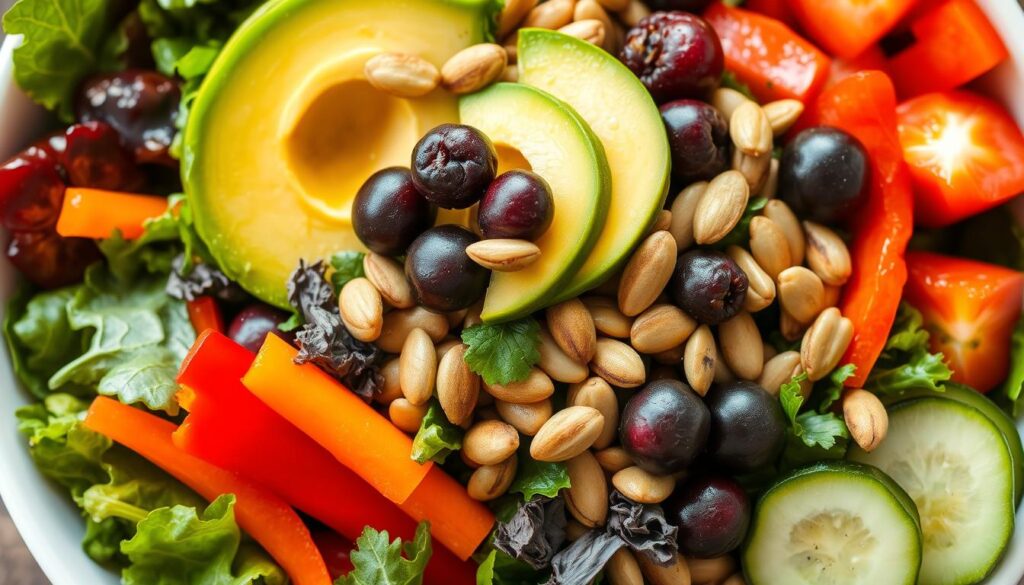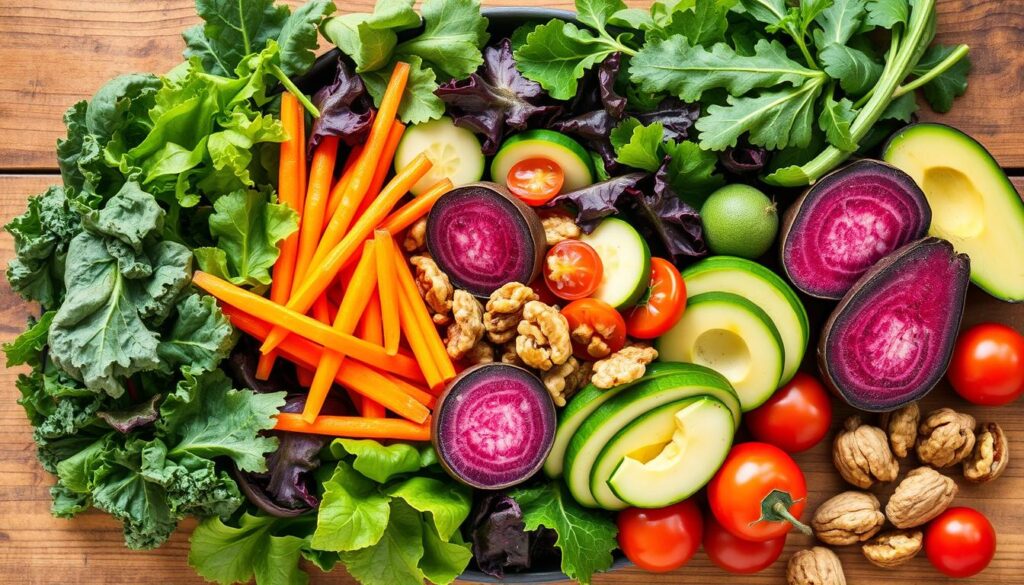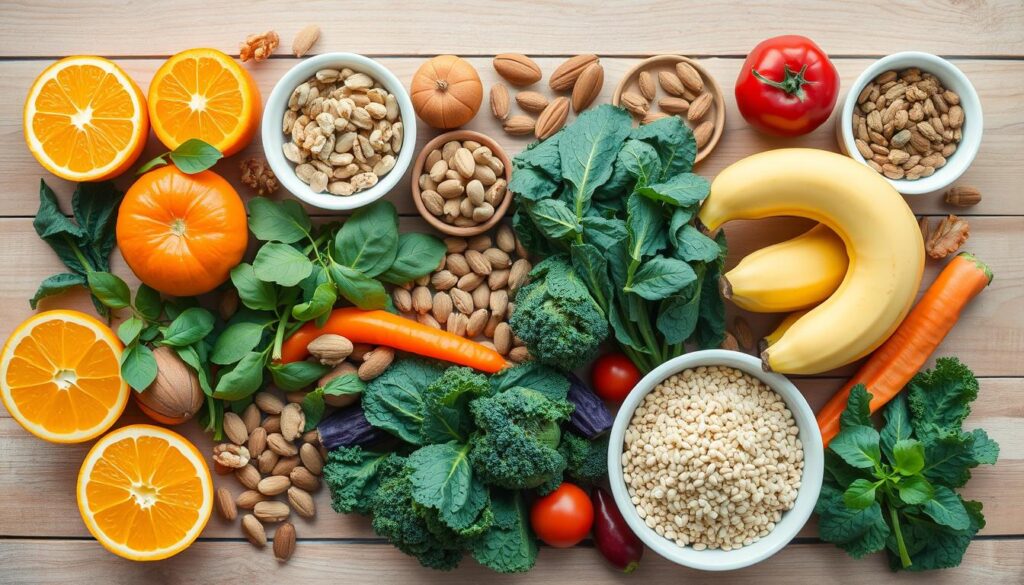Now Reading: Best Salad for Vitiligo – Make at Home with This Guide
-
01
Best Salad for Vitiligo – Make at Home with This Guide
Best Salad for Vitiligo – Make at Home with This Guide

Learning to make the best salad for vitiligo at home can change your life. A good salad can give you the nutrients your skin needs. With a homemade recipe, you can control your diet and improve your health.
Making a tasty and healthy vitiligo-friendly salad is simple. Just pick the right ingredients and follow a few tips. This guide will show you how to make a salad that’s good for you and tastes great.
Introduction to Vitiligo-Friendly Salads
A vitiligo-friendly salad is more than food; it’s a health boost. By making your own salad, you start a healthy diet. Enjoy a meal that’s good for your skin and overall health.
Key Takeaways
- Learning how to make best salad for vitiligo at home can be beneficial for individuals living with vitiligo
- A vitiligo-friendly salad can provide essential nutrients that support skin health and overall well-being
- A homemade vitiligo-friendly salad recipe can be a great way to take control of your diet and make a positive impact on your health
- Creating a delicious and nutritious vitiligo-friendly salad is easier than you think
- Incorporating the right ingredients and following a few simple tips can make a big difference in the quality of your salad
- A vitiligo-friendly salad is a great way to support your overall health and well-being
Understanding the Role of Diet in Vitiligo Management
A well-balanced diet is key in managing vitiligo, a skin condition. Eating lots of fruits, vegetables, and whole grains can help. A nutritious salad is a great way to add these nutrients to your meals.
There are many easy salad ideas for vitiligo patients. Start with dark leafy greens like kale or spinach. Add colorful veggies like bell peppers, carrots, and cherry tomatoes. Don’t forget protein sources like grilled chicken or salmon to help your skin heal.
Some important ingredients for a vitiligo-friendly salad are:
- Leafy greens, like kale and spinach
- Colorful vegetables, like bell peppers and carrots
- Protein sources, like grilled chicken and salmon
- Healthy fats, like avocado and nuts
Adding these ingredients to your diet can support your skin’s health. A nutritious salad is a tasty and simple way to start.

Essential Nutrients That Support Skin Health in Vitiligo
Managing vitiligo well means eating right. Adding the best salad recipes for vitiligo to your diet is key. These salads are packed with nutrients like vitamin D, omega-3 fatty acids, and antioxidants. They help ease symptoms and boost your health.
Key nutrients for skin health in vitiligo include:
- Vitamin D: essential for skin cell growth and differentiation
- Omega-3 fatty acids: reduce inflammation and promote healthy skin
- Antioxidants: protect the skin from damage caused by free radicals
A vitiligo diet salad with fatty fish, nuts, and leafy greens is great. It gives you these important nutrients. Adding these salads to your diet helps manage your condition and keeps your skin healthy.

Choosing the right foods and adding nutrient-rich salads to your meals is a big step. It helps manage vitiligo and keeps your skin in good shape. With the right diet, you can lessen symptoms and live better.
| Nutrient | Food Sources | Benefits for Vitiligo |
|---|---|---|
| Vitamin D | Fatty fish, fortified dairy products | Supports skin cell growth and differentiation |
| Omega-3 fatty acids | Nuts, seeds, fatty fish | Reduces inflammation and promotes healthy skin |
| Antioxidants | Leafy greens, berries, other fruits and vegetables | Protects the skin from damage caused by free radicals |
Key Ingredients for Your Vitiligo-Friendly Salad
Creating a healthy vitiligo-friendly salad is all about the right ingredients. A good salad gives you essential nutrients, antioxidants, and proteins. These help your skin stay healthy. Eating foods good for vitiligo can help manage symptoms and improve your overall health.
Antioxidant-Rich Vegetables
Vegetables like leafy greens, bell peppers, and carrots are full of nutrients. They protect your skin from harm. Adding them to your salad makes for a tasty and healthy meal.
Protein Sources for Skin Repair
Proteins like grilled chicken, salmon, and tofu are key for skin repair. They help your skin heal and grow. Adding these to your salad supports your skin’s health.
Beneficial Fruits and Berries
Fruits and berries like blueberries, strawberries, and raspberries are full of antioxidants. They’re good for your skin. Adding them to your salad makes for a sweet and healthy treat.

Using these ingredients in your salad makes for a delicious and healthy meal. Choose fresh, seasonal ingredients. Try different combinations to find your favorite healthy foods.
How to Make Best Salad for Vitiligo at Home
To make a tasty and healthy homemade vitiligo-friendly salad recipe, you need a few ingredients and basic tools. These will help you create salads that are good for your skin and taste great.
Here’s how to do it:
- Choose fresh, healthy ingredients like veggies, proteins, and fruits.
- Put these ingredients together for a balanced salad.
- Use a dressing that matches your salad’s flavors and adds health benefits.
By following these steps and picking your favorite ingredients, you can make a homemade vitiligo-friendly salad recipe at home. Always use fresh, wholesome ingredients for the best results.
Choosing the Perfect Base for Your Vitiligo Salad
Creating a great salad for vitiligo patients starts with the base. A good base can greatly improve the salad’s taste and health benefits. For those with vitiligo, it’s key to pick a base that’s full of nutrients and antioxidants.
Studies suggest dark leafy greens and microgreens are top picks for a vitiligo salad base. These greens are loaded with vitamins, minerals, and antioxidants. They help fight inflammation and support skin health. Kale, spinach, and collard greens are great options. Microgreens like pea shoots and radish greens are also excellent choices.
Dark Leafy Greens Options
Dark leafy greens are a fantastic choice for a vitiligo salad base. They are full of antioxidants and nutrients. Here are some benefits:
- High in vitamins A, C, and K
- Rich in minerals like calcium and iron
- Packed with antioxidants to reduce inflammation
Microgreens and Sprouts Selection
Microgreens and sprouts are young, nutrient-rich versions of greens and veggies. They’re a great addition to a vitiligo salad base. Here’s why:
- High in vitamins and minerals
- Rich in antioxidants and other phytochemicals
- Easy to digest and can be added to various salads
Choosing the right base for your vitiligo salad can make a big difference. It helps create a tasty and healthy meal that supports your skin and overall health. Whether you like dark leafy greens or microgreens, there are many salad ideas to try. Experiment with different combinations to find your perfect salad.
Best Dressing Recipes for Vitiligo-Friendly Salads
When it comes to best salad recipes for vitiligo, the dressing is key. It boosts flavor and nutrition. A vitiligo diet salad is more than just ingredients. It’s about the dressing that ties it all together.
Studies show that olive oil, lemon juice, and herbs are great for salad dressings. Here are some tasty and healthy options for vitiligo-friendly salads:
- Olive oil and lemon juice vinaigrette
- Herb-infused dressing with basil and parsley
- Apple cider vinegar dressing with a hint of honey
These dressings are not only yummy but also good for your skin. Adding them to your best salad recipes for vitiligo makes a vitiligo diet salad that’s both tasty and healthy.
Seasonal Variations of Vitiligo-Supporting Salads
As the seasons change, so do the ingredients for healthy vitiligo-friendly salads. Using seasonal fruits and vegetables keeps your salads fresh and nutritious.
A healthy vitiligo-friendly salad can vary with the season. For instance, summer brings fresh berries, citrus fruits, and leafy greens. These make a refreshing and nutritious salad.
Summer Blend Options
- Fresh berries with mixed greens and a citrus vinaigrette
- Grilled chicken or fish with roasted vegetables and quinoa
- A mix of seasonal fruits, such as peaches and pineapple, with a dollop of yogurt
Winter Warming Combinations
In winter, warm ingredients like roasted sweet potatoes and Brussels sprouts are great. They make a nourishing vitiligo-friendly salad.
Spring Detox Variations
Spring is the time for detoxifying ingredients. Leafy greens and citrus fruits are perfect. They create a refreshing and healthy vitiligo-friendly salad.
Tips for Maximizing Nutrient Absorption
To get the most out of your homemade vitiligo-friendly salad recipe, focus on nutrient absorption. The right food combinations and preparation are key. This way, you can boost the nutritional value of your salads.
Studies show that mixing certain foods can make nutrients more available. For example, eating vitamin C-rich foods like citrus or bell peppers with iron-rich foods like spinach boosts iron absorption. Also, adding healthy fats like avocado or nuts to salads with vitamins A, D, E, and K can help absorb these vitamins better.
Proper Food Combinations
- Combine vitamin C-rich foods with iron-rich foods to improve iron absorption
- Pair healthy fats with fat-soluble vitamins to enhance their absorption
- Include a variety of colorful vegetables to maximize antioxidant intake
Preparation Techniques
How you prepare your food matters for nutrient absorption. Light steaming or sautéing veggies can keep their nutrients. But overcooking can lose important vitamins and minerals. Using fresh, quality ingredients and reducing waste makes your salads both tasty and healthy.
Common Mistakes to Avoid When Making Vitiligo-Friendly Salads
When making vitiligo-friendly foods, it’s key to watch out for common mistakes. These can hurt the nutritional value and effectiveness of your healthy vitiligo-friendly salad. One big error is using unhealthy ingredients like processed meats or high-sugar dressings. These can make vitiligo symptoms worse.
Another mistake is not preparing ingredients right. Overcooking or overheating can cause a loss of important nutrients. To fix this, use fresh, whole ingredients and gentle preparation methods.
Some common mistakes to avoid when making vitiligo-friendly salads include:
- Using low-quality or processed ingredients
- Overcooking or overheating ingredients
- Not balancing nutrient intake
- Ignoring proper food storage and handling
By knowing these common mistakes and avoiding them, you can make healthy vitiligo-friendly salads. These salads will not only taste good but also help support skin health and manage vitiligo.
| Mistake | Consequence | Solution |
|---|---|---|
| Using unhealthy ingredients | Negative impact on vitiligo symptoms | Focus on whole, fresh ingredients |
| Improper preparation techniques | Loss of essential nutrients | Use gentle preparation methods |
Meal Planning and Storage Tips
Preparing easy vitiligo-friendly salads is all about planning and storage. A well-thought-out salad can greatly help manage vitiligo. Start by preparing ingredients ahead of time to save time later. This includes chopping veggies, cooking proteins, and mixing dressings.
For easy meals, make a big batch of salad on the weekend. Then, portion it out for the week. This way, you’ll always have a healthy salad ready. Use airtight containers and mason jars to keep your salads fresh.
Make-Ahead Strategies
- Prepare ingredients in advance
- Portion out salads for the week
- Use storage solutions like airtight containers and mason jars
Storage Solutions
Keeping salads fresh and safe is key. Use airtight containers or mason jars with tight lids. Adding a paper towel can absorb moisture and keep the salad fresh.
Freshness Duration Guidelines
It’s important to know how long salads stay fresh. Most can be stored in the fridge for 3-5 days. Always check the salad for spoilage before eating.
| Salad Type | Storage Duration |
|---|---|
| Green Salad | 3-5 days |
| Fruit Salad | 2-3 days |
| Protein Salad | 3-5 days |
Additional Health Benefits Beyond Vitiligo Support
Eating a balanced diet, like best salad recipes for vitiligo, offers many health perks. A good vitiligo diet salad can lower inflammation, boost health, and strengthen the immune system.
Some key benefits of a balanced diet include:
- Improved skin health
- Enhanced immune function
- Reduced risk of chronic diseases
- Increased energy levels
A vitiligo diet salad full of antioxidants, vitamins, and minerals can ease symptoms. It also supports overall well-being. By adding best salad recipes for vitiligo to your meals, you can see these benefits and enhance your life quality.
Always talk to a healthcare expert or a registered dietitian. They can help make a meal plan that fits your needs and health goals.
| Benefit | Description |
|---|---|
| Reduced Inflammation | Helps alleviate symptoms and supports overall health |
| Improved Skin Health | Supports skin repair and reduces risk of skin conditions |
| Enhanced Immune Function | Boosts immune system and reduces risk of illnesses |
Conclusion: Embracing a Healing Diet Through Fresh Salads
Adding fresh, nutrient-rich salads to your daily meals can help manage vitiligo and improve skin health. By making homemade vitiligo-friendly salad recipes a staple, you tap into nature’s healing power. This way, you actively contribute to your health.
Choosing a healing diet with fresh salads means feeding your body lots of antioxidants, vitamins, and minerals. These help fight inflammation, aid in skin repair, and might even slow vitiligo progression. With the right mix of greens, veggies, proteins, and dressings, you can make tasty, healthy salads. They not only please your palate but also boost your health.
Managing vitiligo is a journey that involves your whole self. By regularly making how to make best salad for vitiligo at home, you’re taking a significant step. This step helps you regain your skin’s glow and overall health. So, let’s celebrate with vibrant, healthy salads that nourish both our bodies and spirits.
FAQ
What are the key ingredients for a vitiligo-friendly salad?
For a vitiligo-friendly salad, use veggies like spinach, kale, and bell peppers. Add protein from grilled chicken or tofu. Don’t forget fruits and berries like blueberries and strawberries.
How can I maximize nutrient absorption in my vitiligo-friendly salad?
To boost nutrient absorption, pair vitamin C-rich foods with iron-rich ones. Use light steaming or massaging greens. This breaks down cell walls, making nutrients easier to absorb.
What are some common mistakes to avoid when making vitiligo-friendly salads?
Avoid unhealthy dressings and toppings. Make sure to include a variety of ingredients. Also, store your salad parts properly to keep them fresh and nutritious.
How can I incorporate seasonal variations into my vitiligo-supporting salads?
Use seasonal fruits, veggies, and herbs in your salads. In summer, try watermelon, feta, and mint. For winter, go for roasted sweet potatoes, quinoa, and nuts.
What are the additional health benefits of a vitiligo-friendly salad diet?
A salad diet rich in nutrients does more than help with vitiligo. It can also lower inflammation, improve gut health, and boost overall well-being.




















